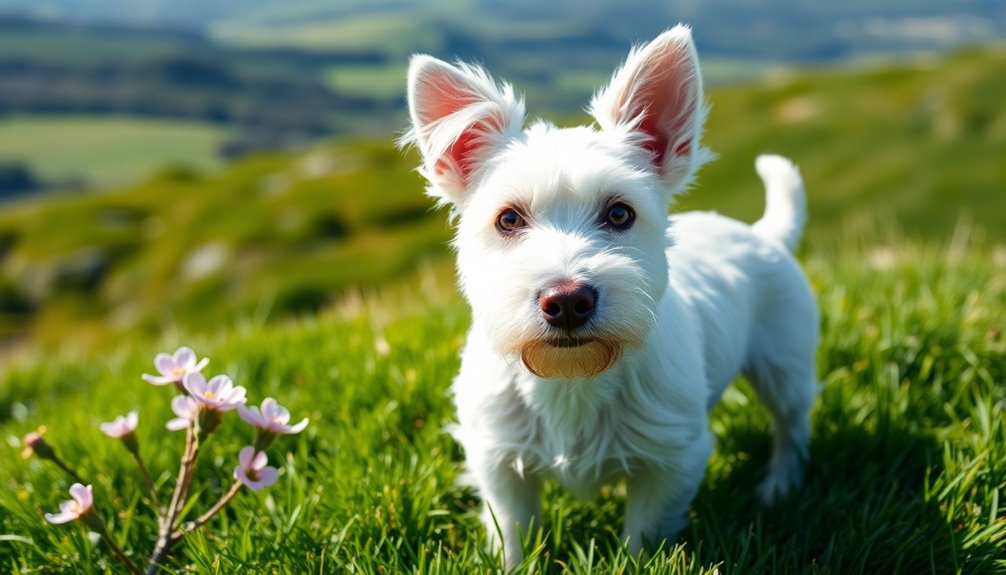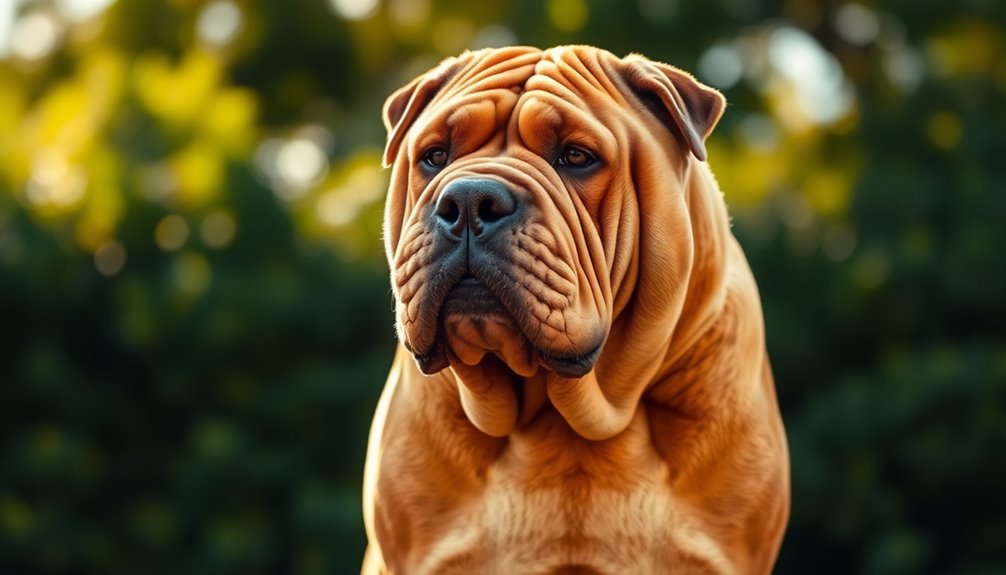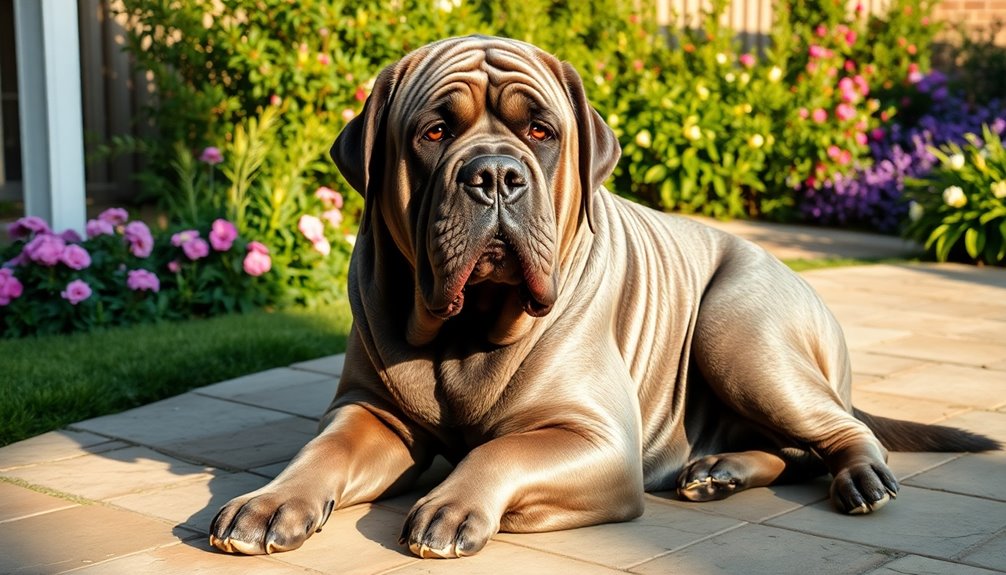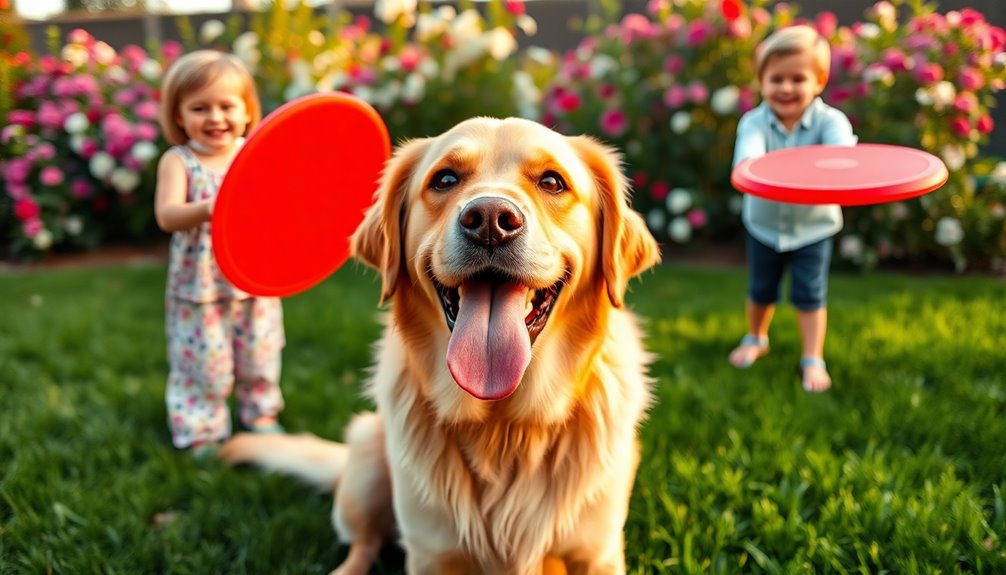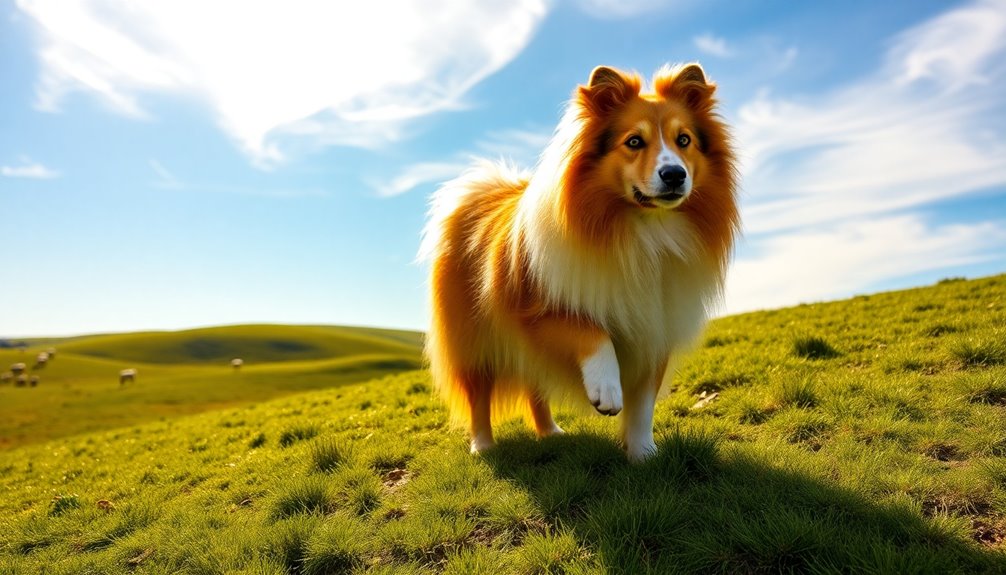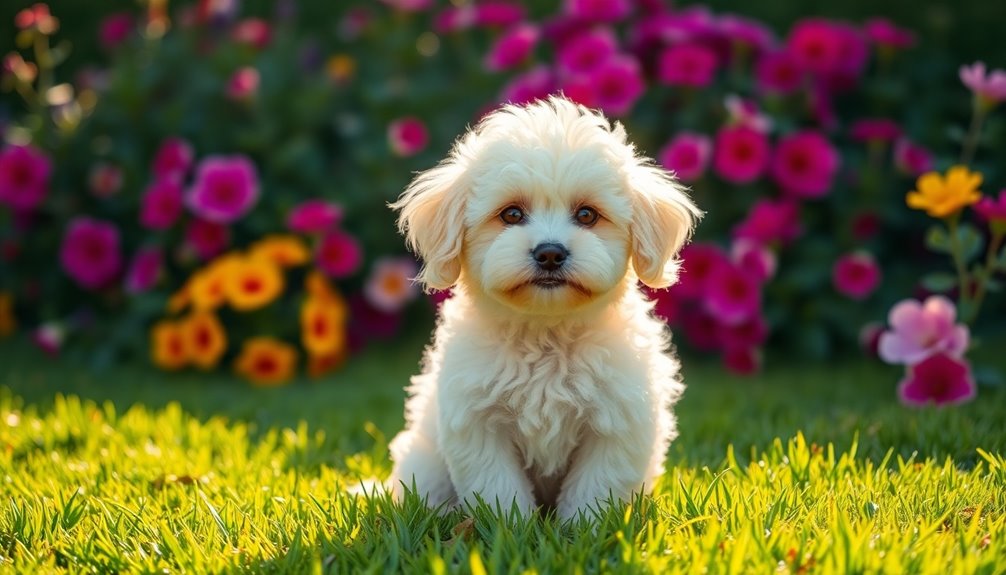The Sealyham Terrier is a rare and charming breed you're sure to adore. Originating in Wales, these small dogs are known for their distinctive beard and bushy eyebrows, giving them a unique look. They stand about 10 to 12 inches tall and weigh between 20 to 24 pounds. Loyal and protective, they make excellent family pets and companions. Though they require regular grooming and daily exercise, their affectionate nature makes it all worth it. If you're curious about their care needs, health concerns, and training tips, there's plenty more to explore about these delightful dogs.
Key Takeaways
- The Sealyham Terrier, originating from Wales, is known for its strong, charming appearance and distinctive beard and bushy eyebrows.
- This breed is affectionate, loyal, and protective, making them excellent companions for families and individuals.
- Sealyham Terriers require regular grooming and exercise, needing 1 to 1.5 hours of daily activity to stay healthy and happy.
- They are classified as a Vulnerable Native Breed, transitioning from hunting companions to beloved family pets over time.
- Common health concerns include ear infections, eye issues, and joint problems, emphasizing the need for preventive care and regular vet check-ups.
Introduction

The Sealyham Terrier is a charming and spirited breed that captures the hearts of many dog lovers. Standing between 10 to 12 inches tall and weighing 20 to 24 pounds, these short-legged dogs boast a strong, slightly elongated body. Their distinctive weather-resistant double coat features a dense, soft undercoat complemented by a wiry, hard outer layer. You'll find them in all white or with lemon, brown, blue, or badger markings, adding to their unique appeal.
With an affectionate and loyal disposition, Sealyham Terriers are devoted companions to their families, though they often remain reserved with strangers. Their strong-willed and boisterous nature makes them playful and energetic, thriving on games that engage both their minds and bodies. They are known for their high-energy, requiring mental and physical stimulation to stay happy and healthy.
While they're highly intelligent, their independent thinking can lead to stubbornness, so early obedience training and socialization are essential.
These dogs require moderate daily exercise, enjoying lively play sessions or short walks. However, be prepared for grooming, as their coat needs combing a few times a week.
With proper care, the Sealyham Terrier can be a delightful addition to any home, bringing joy and companionship to your life.
History and Origin
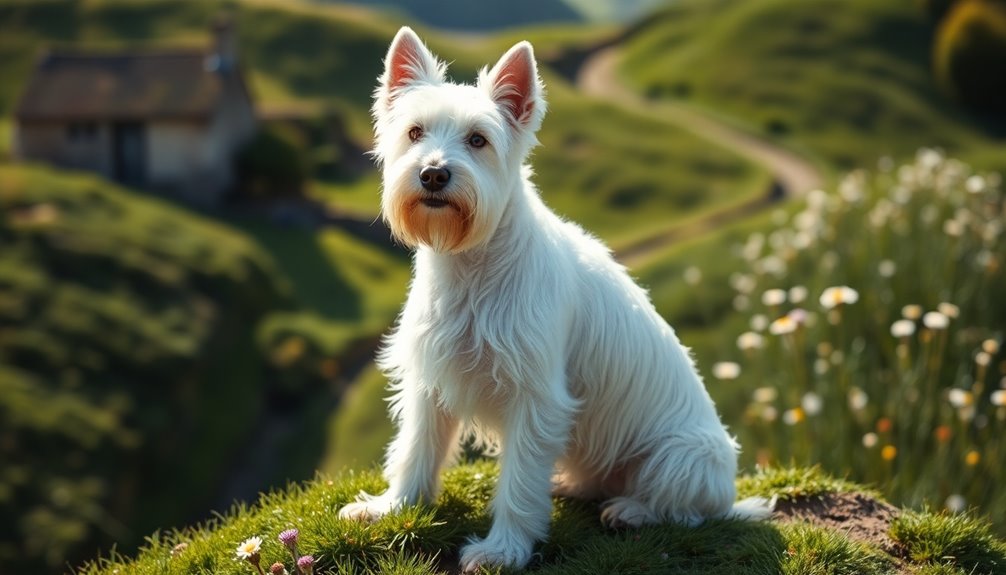
The Sealyham Terrier originated in Pembrokeshire, Wales, between 1850 and 1891, thanks to Captain John Edwardes. He aimed to create a robust working terrier specifically for badger hunting and vermin control. This breed was named after Sealyham estate in Haverfordwest, reflecting its strong ties to the region.
Where and when the breed originated
Originating in Wales, the Sealyham Terrier was developed at Sealyham House, near Wolfscastle in Pembrokeshire. This charming breed emerged between 1850 and 1891, thanks to Captain John Edwardes, who initiated the breeding program around 1848. While exact records are scarce, Edwardes' work laid the foundation for the breed until his death in 1891. Afterward, other breeders, including Fred Lewis, continued to refine and promote the Sealyham Terrier. The breed takes its name from the Sealyham estate, closely linked to the Sealy and Western Cleddau rivers, which enrich the landscape of Pembrokeshire. The Sealyham Terrier was primarily bred for hunting small game, showcasing its hunting abilities and versatility. The Sealyham Terrier made its first recorded show appearance in 1903 in Wales, showcasing its growing popularity. In 1908, the Sealyham Terrier Club was formed, further solidifying the breed's presence in the canine community.
Badger Hunting and Vermin Control
Sealyham Terriers were specifically bred for the demanding task of badger hunting and vermin control, showcasing their unique skills in navigating challenging terrains.
With their short legs and sturdy build, they could dig out badgers, otters, and even foxes from their dens. Their courage and intelligence were essential, enabling them to maneuver through dark, cold, and damp passages while relying on their keen sense of smell and sound to locate their quarry.
These dogs were trained to find badgers without engaging them directly, using a method known as 'holding the badger.' This technique involved nipping at the badger and retreating to prevent its escape, ensuring the safety of the young terriers who often accompanied older, experienced dogs. The badger setts where they hunted often contained multiple chambers and were home to various species, highlighting the complex ecological role of these environments.
Over time, as the need for vermin control diminished, the Sealyham Terrier transitioned from a practical hunting companion to a beloved family pet.
Despite their hunting instincts, Sealyham Terriers are friendly and adaptable. They respond well to positive reinforcement training and excel in activities that stimulate their minds, making them both charming companions and skilled hunters when needed.
Physical Characteristics
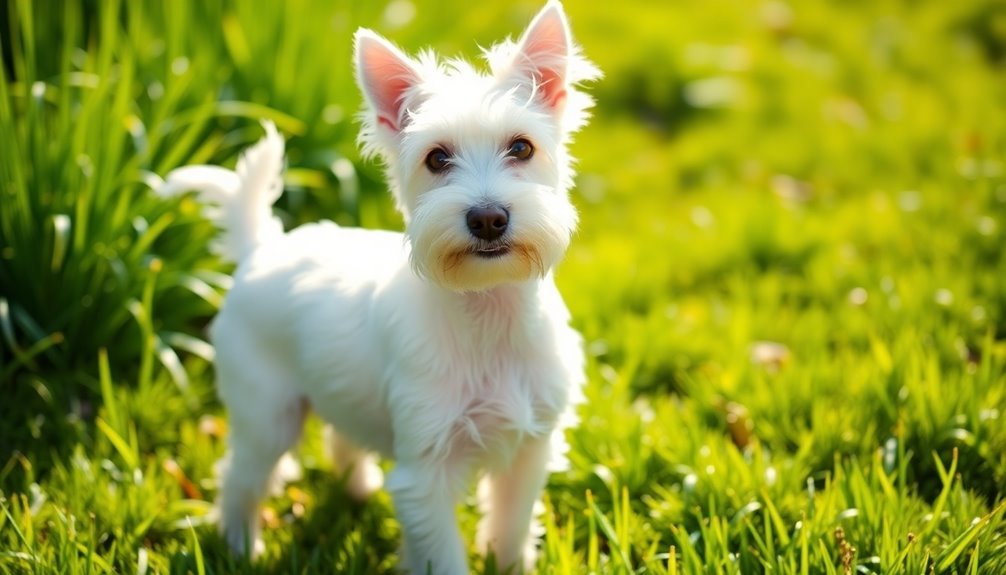
When you look at a Sealyham Terrier, you'll notice their compact size, standing between 8 to 11 inches tall and weighing around 18 to 20 pounds. Their distinctive double coat features a soft undercoat and a wiry outer layer, often seen in white or with lemon, tan, or badger markings. Plus, their beard and bushy eyebrows give them a charming, alert expression that sets them apart. This breed typically has an average life expectancy of about 13.1 years, which is longer than many other purebred dogs.
Size, weight, and coat details
With a compact and sturdy build, the Sealyham Terrier typically stands between 10.5 and 12 inches tall at the shoulder and weighs between 18 and 24 pounds. Males usually weigh around 20 pounds, while females average about 18 pounds. Their overall body length ranges from 16 to 20 inches, giving them a well-proportioned appearance.
This breed features a double coat, consisting of a wiry outer coat and a finer, softer undercoat. The outer coat is coarse, wiry, and weather-resistant, making it suitable for various environments. Despite their dense fur, they shed minimally, which is a plus for many dog owners. However, regular brushing is essential to prevent matting.
Primarily white, Sealyham Terriers can also display markings in lemon, black, brown, blue, or a combination of these colors. While some markings are acceptable, heavy body markings are discouraged, and excessive ticking should be avoided. Their health issues can include conditions like hip dysplasia and primary lens luxation, so regular grooming and veterinary care are vital for their well-being.
Their unique coat not only adds to their charm but also requires some grooming attention to keep them looking their best. Overall, the Sealyham's size, weight, and coat contribute to its distinctive and appealing presence.
Beard and Bushy Eyebrows
The Sealyham Terrier's appeal extends beyond its compact body and distinctive coat to its striking facial features, particularly the beard and bushy eyebrows. These features not only enhance its charm but also reflect the breed's hunting origins.
The robust beard grows in tufts above the nose and under the chin, requiring regular trimming to prevent matting and tangling. If left untrimmed, it can obstruct your dog's eyesight. The breed's lifespan typically ranges from 12 to 15 years, making it a long-term companion.
Made of wiry hair, the beard aligns with the overall coat type and contributes to the dog's dirt-repellent nature. Daily brushing keeps it clean and untangled, but it's best to have a specialist handle the trimming to avoid damaging the coat.
The bushy eyebrows are equally essential, adding to the breed's expressive and charming face. This long hair grows on the forehead and requires regular grooming to prevent matting and keep the eyes clear.
Together, the eyebrows and beard create a rugged appearance that complements the Sealyham Terrier's slightly domed head and powerful jaw. These features make your dog alert and expressive, solidifying its unique and recognizable look.
Temperament and Personality
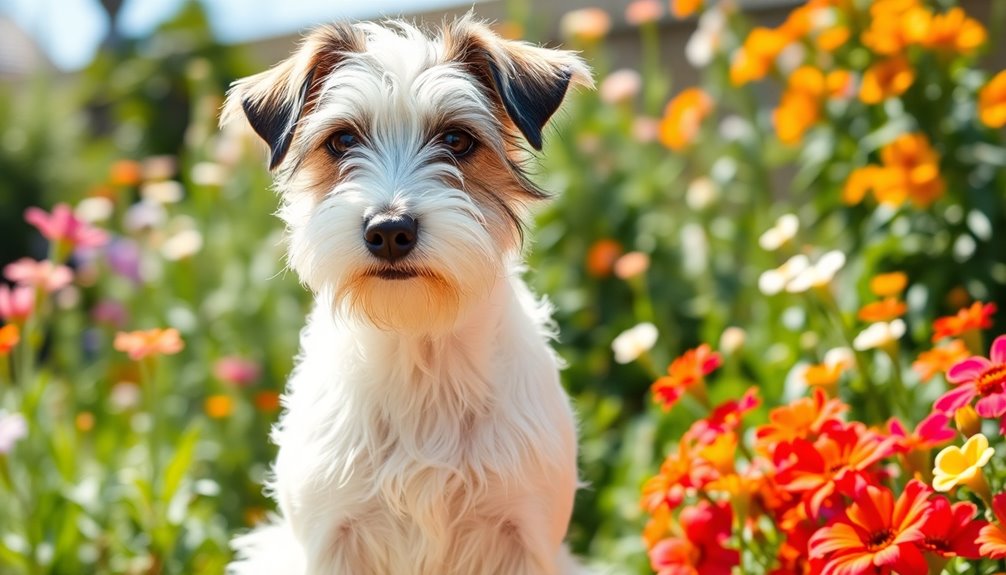
The Sealyham Terrier's playful and spirited demeanor makes them a delightful companion for families and individuals alike. You'll find that their affectionate nature allows them to bond well with other pets when properly socialized. With their confident personality, they can bring joy and energy to your home. Their independent and stubborn traits can also add to their charm, making them unique among terrier breeds.
Playful and Spirited Demeanor
However, their spirited nature comes with its quirks. They can be stubborn and strong-willed, so early socialization and consistent training are necessary. With positive reinforcement, you can help them channel their playful energy productively. Just be prepared for some possessiveness over toys and food, as they love to keep their cherished belongings close. Additionally, their calm demeanor among terriers makes them a unique choice for families looking for a lively yet composed companion. All in all, their exuberance and charm will surely keep you on your toes!
Suitability for families, individuals, or other pets
Sealyham Terriers make excellent companions for both families and individuals, thanks to their loyal and affectionate nature. They're fiercely protective of their loved ones, making them great watchdogs. When properly socialized from a young age, they're generally good with children, though you'll need to supervise interactions to prevent rough play.
These adaptable dogs thrive in various living environments, whether you live in an apartment or a house. For individuals, Sealyham Terriers form strong bonds and enjoy spending quality time together. They can be independent thinkers, so you'll need patience and consistency in training. A leisurely daily walk usually meets their moderate exercise needs, but they also crave attention to stay engaged. Additionally, their calm and relaxed demeanor makes them suitable for both city and country living. Foster parent pay can vary significantly, but it is essential to ensure a stable environment when considering any pet.
When it comes to other pets, socialization is key. They can be friendly with other dogs if supervised, but be prepared for potential dominance issues. Their prey drive means you should exercise caution around small animals, including cats, though early training can help them coexist peacefully.
Health and Lifespan
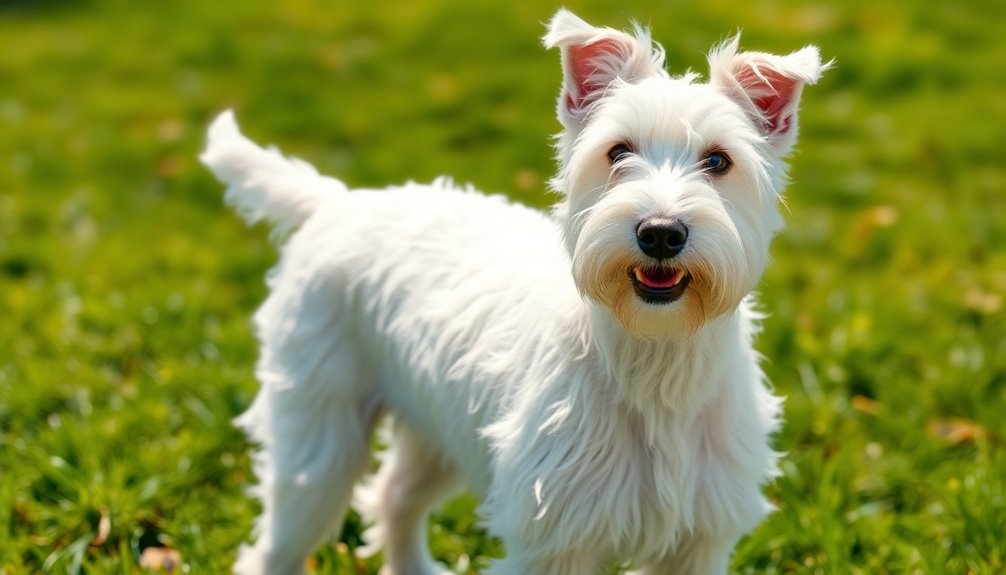
When it comes to your Sealyham Terrier's health and lifespan, you can expect an average of 12 to 14 years of companionship. However, be aware of common health concerns like ear infections and eye issues that can impact their quality of life. Regular vet check-ups are essential for ongoing health monitoring to catch any potential problems early on.
Typical lifespan of the breed
The typical lifespan of a Sealyham Terrier ranges from 12 to 14 years, with some individuals living up to 15 years. This longevity is generally consistent with their size and breed characteristics. When you adopt a Sealyham Terrier as a puppy, you're committing to a decade or more of companionship, which is an important aspect to consider.
Several factors influence this breed's lifespan. Genetic health plays a significant role, so focusing on preventive healthcare and regular veterinary check-ups is crucial. Providing a proper diet and nutrition will also positively impact their longevity. Additionally, regular monitoring for breed-specific health issues can help in early detection and management.
Don't forget about dental care; maintaining their teeth can prevent disease that may shorten their lives.
A Sealyham's lifestyle and care directly affect their health and lifespan. They require moderate exercise, so daily leisurely walks will keep them fit. Regular grooming helps prevent matting, while proper training and socialization ensure they adapt well to family life.
Common health concerns or genetic predispositions
Common health concerns and genetic predispositions can significantly impact a Sealyham Terrier's quality of life and lifespan. One major issue is eye problems, such as Primary Lens Luxation (PLL), which can lead to glaucoma and blindness if not managed.
Regular vet check-ups are essential to monitor for cataracts and Progressive Retinal Atrophy (PRA), an inherited condition that causes gradual vision loss. Additionally, regular eye evaluations are necessary to catch issues early, as conditions like glaucoma can lead to blindness if untreated.
Skin allergies, particularly Atopic Dermatitis, are also common in this breed. You might notice symptoms like itching and redness, which often require dietary adjustments or special shampoos for management.
Joint and musculoskeletal problems, including hip dysplasia, can arise, especially as your dog ages or if they become obese. Maintaining a healthy weight is crucial to prevent or manage these issues and avoid complications like arthritis.
Finally, be aware of neurological conditions such as Degenerative Myelopathy, which typically begins around age nine. Symptoms include weakness in the hind legs and loss of coordination.
Genetic testing can help identify dogs at risk, allowing for better management of their health.
Tips for maintaining health and wellness
Maintaining your Sealyham Terrier's health and wellness is essential for a long, happy life. Start with grooming by brushing their coat every 2-3 days to prevent matting and bathe them at least once a month. Regularly clean their ears to avoid infections, trim their nails to prevent overgrowth, and brush their teeth daily with dog-safe toothpaste to combat dental disease.
Next, focus on nutrition. Provide a balanced diet rich in proteins, fats, carbohydrates, vitamins, and minerals, and ensure they've fresh water available at all times. Consider low-fat dog food to maintain a healthy weight, and monitor for food allergies, adjusting their diet as needed. Limit treats to keep obesity at bay.
Don't forget physical activity! Engage in daily walks and playtime, avoiding extreme temperatures. Sealyham Terriers are known for their strong character, so include mentally stimulating activities like interactive play and training exercises to keep boredom at bay.
Lastly, prioritize veterinary care. Schedule regular check-ups for vaccinations and maintain a preventive health plan. Keep an eye on your dog for any unusual health signs and have a record of their health history for reference.
These steps will help your Sealyham Terrier thrive!
Care Requirements
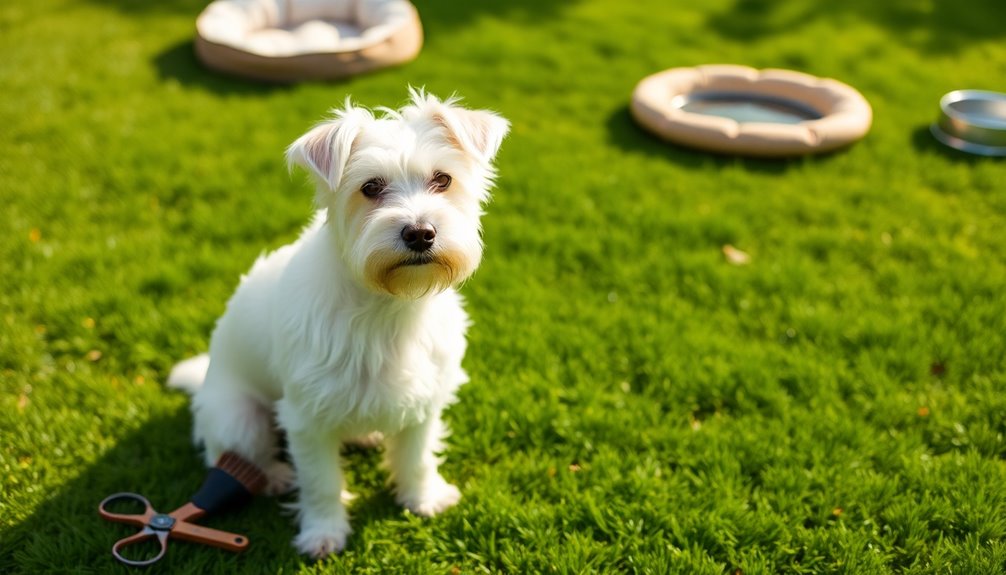
Caring for a Sealyham Terrier involves regular brushing to keep that wiry coat healthy and free of mats. Additionally, their moderate activity levels mean you'll also need to provide about 1 to 1.5 hours of exercise daily to match their energy levels. Plus, paying attention to their diet with quality food will help maintain their overall well-being.
Regular Brushing Required
Regular brushing is essential for keeping your Sealyham Terrier's coat in top condition. With their double coat featuring a coarse outer layer and a finer undercoat, your dog needs consistent grooming to maintain its health and appearance. Aim to brush at least once a week, though two to three times weekly is ideal to prevent matting and tangling. This routine not only keeps the coat looking its best but also helps distribute natural skin oils. Additionally, this breed is known for its distinctive white coat, which makes them easily visible during outdoor activities.
Every three months, you should perform hand stripping to remove dead hairs and stimulate healthy circulation. While clipping is an option, it softens the coat, so hand stripping is generally preferred. Professional grooming can also be beneficial to maintain the texture and overall appearance of your Sealyham's coat.
Aside from brushing, don't forget other grooming tasks. Regularly trim your dog's nails, clean their ears, and brush their teeth ideally twice a day.
Occasional baths will help keep your furry friend clean and fresh. By sticking to this grooming routine, you'll not only enhance your Sealyham's appearance but also strengthen your bond during these grooming sessions.
Exercise requirements and energy levels
A Sealyham Terrier's exercise needs are crucial for its overall well-being and happiness. You should aim for about 1 to 1.5 hours of exercise daily, which can include short walks, playtime, and mentally stimulating activities.
For puppies, keep play sessions controlled at 15-20 minutes several times a day until they reach adult activity levels around 12 months. Outdoor adventures are great, but be mindful of the weather; early morning or late evening outings help avoid overheating. While these dogs can adapt to apartment living, they'll need consistent exercise to stay calm and manageable indoors.
Always keep them on a leash due to their strong prey drive, and don't let grass stains deter you from outdoor fun. Regular activity not only helps your Sealyham maintain a healthy weight but also reduces undesirable behaviors stemming from boredom. This breed has a low energy level compared to other terrier breeds, making their exercise routine even more essential.
This routine is essential for their physical and mental health, ensuring they don't exhaust themselves. By integrating various activities into their exercise regimen, you'll keep your Sealyham happy, healthy, and well-adjusted.
Feeding tips and diet recommendations
Ensuring your Sealyham Terrier receives a balanced diet is vital for their health and vitality. Focus on providing high-quality protein from animal sources like beef, chicken, or fish, as this is crucial for their body cells and functions. Incorporate essential fatty acids and omegas to support energy levels and overall health. A diet rich in raw feeding can also lead to noticeable improvements in your dog's skin and coat condition.
While they need some carbohydrates, limit starchy options and prioritize vegetables, herbs, and berries for natural vitamins and minerals. Feed your adult Sealyham Terrier two meals daily, monitoring portion sizes to prevent obesity. Always provide fresh water and consider their life stage and energy needs when selecting food. Ground bone can aid digestion and support skin and bone health. Offal is another excellent addition, acting as a natural multivitamin due to its nutrient density.
Be mindful of potential food allergies or sensitivities; consult your veterinarian for tailored advice. Watch for signs of allergies and avoid inappropriate ingredients that may cause inflammation. Treats should be used sparingly and not replace their main diet. Choose dog food that meets your Sealyham's specific nutritional requirements, such as lower-fat options if needed.
Training and Socialization
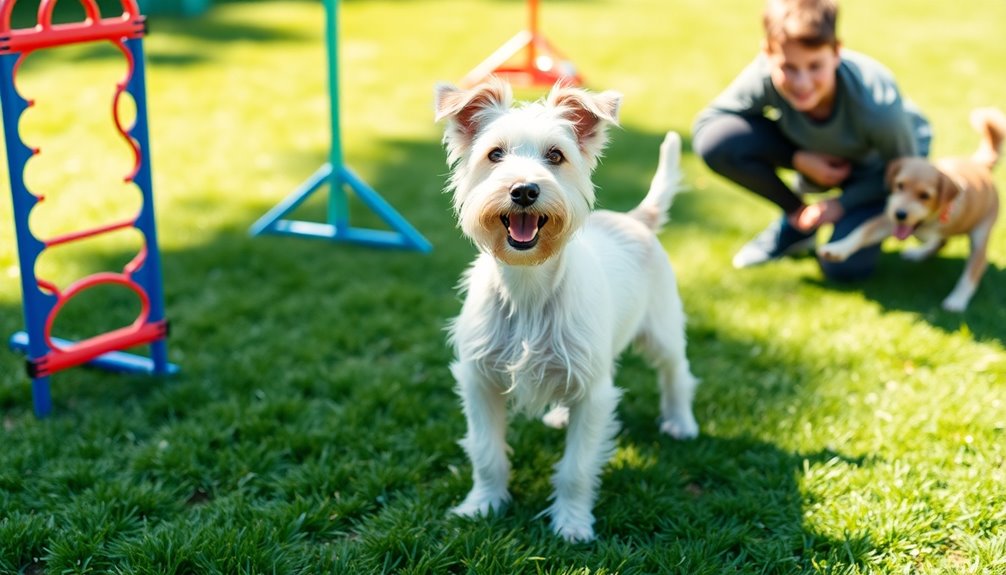
When training your Sealyham Terrier, you'll notice their moderately stubborn temperament, so it's important to be patient and consistent. Gradual introductions to new companions can help ease any potential leash reactivity towards other dogs. Additionally, incorporating music education into their training routine can enhance their responsiveness and focus during sessions.
Moderately Stubborn Training Temperament
Training a Sealyham Terrier can be a rewarding yet challenging experience due to their moderately stubborn temperament. While these intelligent dogs have the ability to learn quickly, their independent nature means they mightn't always follow your commands. To navigate this, keep training sessions short and engaging to hold their attention.
Using positive reinforcement techniques—like treats, praise, and play—is essential for success. Training should start early, ideally during puppyhood, to establish good behavior habits from the get-go. Make it fun and interactive, and consider enrolling in obedience classes to help you establish yourself as the pack leader.
Focus on teaching basic commands such as 'sit,' 'stay,' 'come,' 'leave it,' and 'no.' Consistency and patience are key, as their strong-willed nature can lead to challenges. Additionally, their vulnerable native breed status means that responsible ownership and proper training are crucial for preserving this charming breed.
Remember that daily exercise and mental stimulation will keep your Sealyham happy and reduce the likelihood of behavioral issues. Engaging them with puzzle toys and tricks can also channel their energy positively.
With dedication and the right methods, you'll find training your Sealyham Terrier to be a fulfilling journey, full of joy and connection.
Gradual Introductions to New Companions
Gradually introducing your Sealyham Terrier to new companions is essential for their development and social skills. Start socialization early, ideally within the first 14 weeks of life. Expose your puppy to various people, sights, and sounds in a positive manner to help them adapt.
Enroll in puppy kindergarten classes where they can meet other dogs and people, fostering friendly interactions.
When introducing your Sealyham to other animals, be mindful of their high prey drive. Supervise initial interactions carefully, especially with smaller pets. Gradual introduction and controlled socialization can promote harmony in multi-pet households.
Teach children how to interact properly with your dog to avoid conflicts, ensuring that all encounters are positive.
Your Sealyham may be reserved around strangers. Consistent exposure to different environments and people will help build their confidence. Additionally, providing regular training sessions can reinforce positive behaviors and improve their adaptability in new situations.
Leash Reactivity Towards Other Dogs
Leash reactivity can turn a simple walk into a stressful experience for you and your Sealyham Terrier. This common issue arises when your dog becomes overly excited or aggressive upon seeing other dogs, often resulting in lunging or barking.
Addressing leash reactivity requires a structured training plan focused on changing your dog's emotional response to triggers.
Start with positive reinforcement techniques—use treats and praise to create a positive association with other dogs. Clicker training can enhance this process by marking the exact moment your dog sees a trigger, rewarding calm behavior. Gradually exposing your dog to triggers while maintaining a safe distance is essential to help them feel more comfortable.
Keep training sessions short and engaging to maintain your dog's interest.
Early socialization is crucial; expose your Sealyham Terrier to various environments and stimuli to foster confidence. Regular mental and physical exercise will help reduce excess energy that could contribute to reactivity.
If needed, consider using a head halter for better control, but ensure it's introduced carefully.
If you find yourself struggling, don't hesitate to seek professional help. Consistency and patience are key in changing your dog's behavior, leading to more enjoyable walks together.
Ideal Living Environment
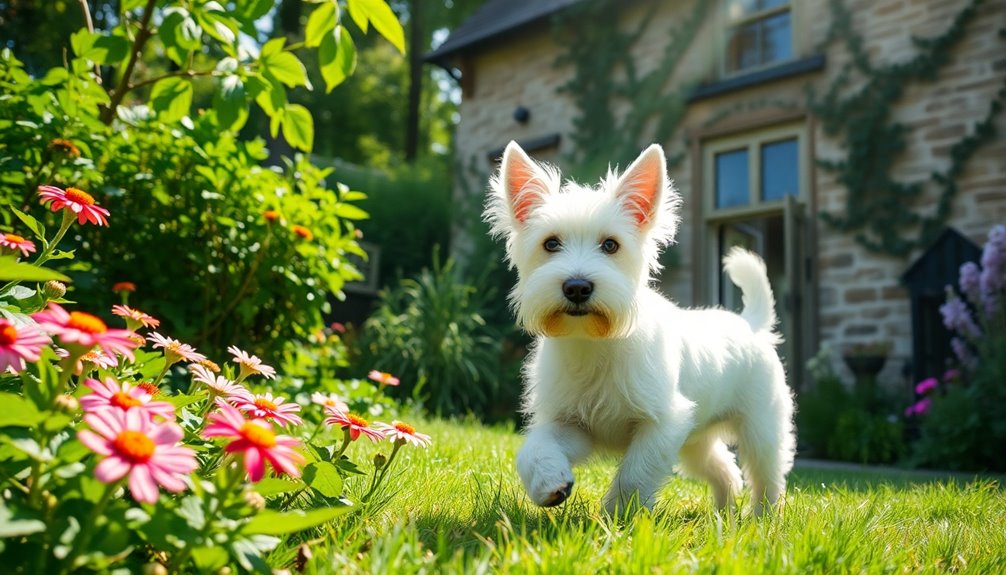
If you're considering a Sealyham Terrier, a house with a secure fence is ideal for their safety and comfort. They thrive in moderate temperature ranges, making cooler climates preferable for their well-being. With the right environment, these dogs can be happy and healthy companions. Regular exercise and playtime are essential to prevent behavior problems, as these dogs are known for their low-energy breed.
House With a Secure Fence
A secure, fenced yard is essential for your Sealyham Terrier, as it ensures their safety and prevents them from escaping. This breed has a strong chase instinct, so a fenced area helps manage that natural tendency and keeps them from pursuing small animals.
With a secure fence, you can allow your Sealyham to enjoy supervised playtime and exercise without worrying about them getting into trouble or danger. A well-fenced yard not only protects your dog but also safeguards small children and other pets from their prey drive. Additionally, because Sealyham Terriers are known for their friendly disposition, they can interact safely with family members and other pets in a secure environment.
Daily walks are still crucial, and when you take them out, always use a securely leashed approach. Engaging in frequent play sessions and family activities will keep your Sealyham happy and mentally stimulated.
They thrive in environments where they can participate in agility, obedience, or even Earthdog competitions, all of which require a safe space to flourish.
Ultimately, a secure fenced yard is more than just a boundary; it's a safe haven for your Sealyham Terrier, ensuring they can enjoy their outdoor time while minimizing risks to themselves and others.
Prefers Moderate Temperature Ranges
Sealyham Terriers thrive in moderate temperature ranges, making it crucial to provide an environment that keeps them comfortable. These charming dogs prefer cool to moderate temperatures, as they can easily overheat in warm weather. Ideally, keep air temperatures below 81-85°F to prevent overheating and excessive panting. Their weather-resistant double coat offers insulation, but it can also intensify the risk of overheating when temperatures rise.
Daily exercise is essential for their happiness and health, but timing is key. Walk them early in the morning or later at night to avoid the heat of the day. While they enjoy a good romp, balance their outdoor activities to prevent exhaustion. Additionally, efficient breathing is crucial for their overall temperature regulation during these activities.
Indoors, Sealyham Terriers are relatively inactive and prefer cool environments. They adapt well to apartment living, but it's vital to maintain a comfortable indoor temperature to avoid panting.
Regular grooming is also necessary to manage their medium-long coat, further ensuring their comfort. By providing a suitable living environment that respects their temperature needs, you can help your Sealyham Terrier thrive and enjoy their life to the fullest.
Loyal Companions Since 1850S
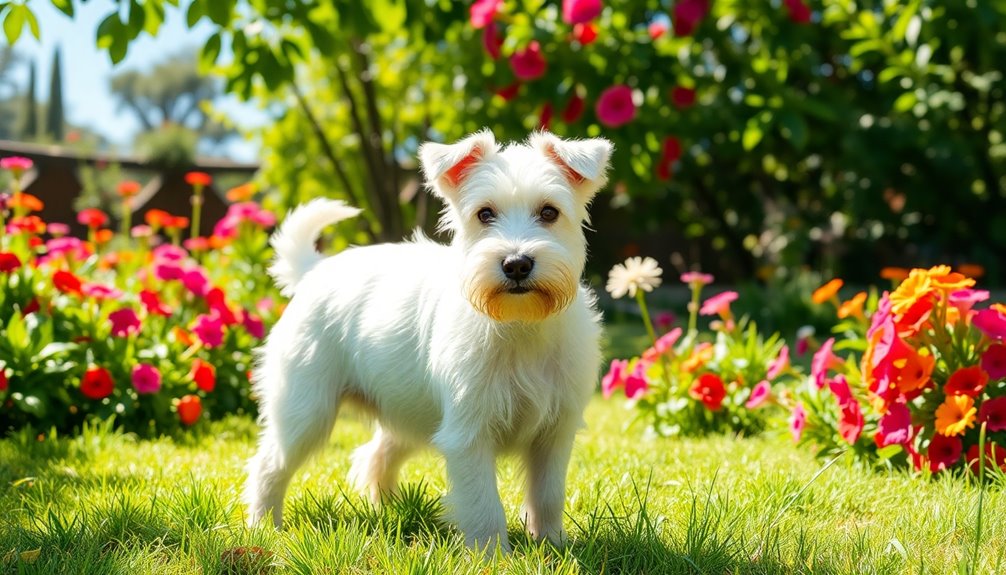
Since their development in the 1850s, Sealyham Terriers have been cherished as loyal companions, yet they rarely make appearances in dog shows. You might've spotted one in popular culture, notably in 'The Queen's Gambit,' which highlights their charm. These spirited dogs continue to capture hearts, proving their worth beyond the competitive arena. Their adaptability as both a family pet and a working terrier showcases their versatility and enduring appeal.
Rarely Seen in Dog Shows
Although they were once popular companions for Hollywood stars and even members of the British royal family, Sealyham Terriers are now rarely seen in dog shows. Originally developed in Wales by Captain John Edwardes from 1850 to 1891, these charming dogs made their show debut in 1903. The American Kennel Club recognized the breed in 1911, but their popularity peaked after World War I and began to decline by the 1930s.
Today, they rank 149th out of 155 breeds in AKC registration numbers, which highlights their dwindling presence. In 2008, only 43 puppies were registered with the Kennel Club in the UK, a stark contrast to their earlier acclaim. The breed is now classified as a Vulnerable Native Breed, reflecting the challenges they face in maintaining genetic diversity and health. Notably, the Sealyham Terrier recently gained recognition as the Best in Show winner at the 2023 National Dog Show, making it a significant moment for the rare breed's resurgence.
Despite their absence from the show ring, Sealyham Terriers remain affectionate, adaptable, and excellent watchdogs. Their spunky nature makes them fantastic family companions, whether in the city or countryside.
For those lucky enough to share their lives with a Sealyham, the charm and loyalty of this breed continue to shine, even outside the limelight.
Featured in 'The Queen's Gambit
In the world of popular culture, the Sealyham Terrier has found a loyal companion in the hit miniseries "The Queen's Gambit." This charming breed not only enhances the story's aesthetic but also symbolizes the warm bonds between characters, reflecting their loyalty and companionship.
These dogs, developed between 1850 and 1891 in Wales, were bred to hunt small game like badgers and foxes, showcasing their robust nature. Standing under 11 inches tall and weighing about 24 pounds, the Sealyham Terrier is known for its wiry double coat and distinctive long facial hair. This breed was once popular in the 1920s and 1930s, demonstrating their significant presence in dog shows during that era.
Their brave, spunky temperament makes them excellent companions, while their strong-willed nature requires consistent training and socialization. Although they're now considered one of the rarest terrier breeds, their popularity surged after World War I, especially among celebrities and even the British royal family.
In "The Queen's Gambit," the Sealyham Terrier not only adds charm but also highlights themes of loyalty that resonate deeply with viewers. As you enjoy the series, remember that these dogs, with their rich history, continue to be cherished companions, making them a perfect fit for any home.
Active Lifestyle Compatibility
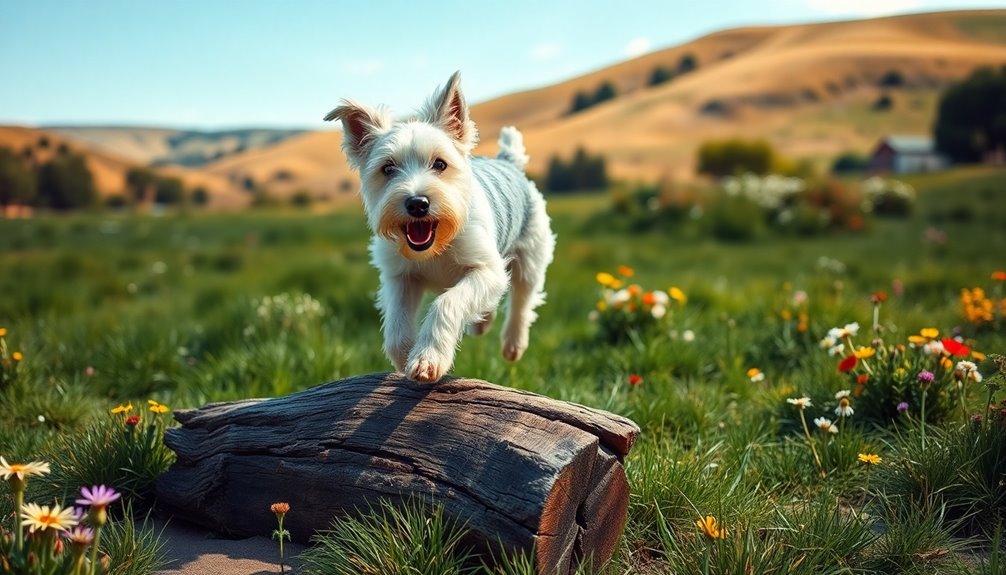
If you lead an active lifestyle, a Sealyham Terrier might be the perfect companion for you.
They thrive on daily walks and playtime, needing about 1 to 1.5 hours of exercise each day to stay happy and healthy.
Just remember that their grooming needs require regular attention to keep their coat in top shape.
Ideal for Active Individuals
Engaging in daily activities with a Sealyham Terrier can be a rewarding experience for active individuals. These charming dogs thrive on 1 to 1.5 hours of exercise each day, making them perfect companions for your active lifestyle.
You'll want to incorporate daily walks, play sessions, and interactive games to keep them happy and healthy. For puppies, aim for 15 to 20 minutes of controlled play several times a day, gradually increasing their activity as they grow.
Sealyham Terriers also need mental stimulation to stay satisfied. Engage them with interactive play and training exercises, or try activities like nose work to keep their minds sharp.
Short, fun training sessions not only maintain their mental health but also reduce the likelihood of behavioral issues.
These adaptable dogs can thrive in various living environments, from apartments to rural settings. They require frequent attention from their family, so be ready to spend quality time with them.
Early socialization and training help them adjust to different situations and interact well with other pets. With the right balance of exercise and mental engagement, your Sealyham Terrier will be a delightful companion in your active life.
Grooming Needs and Maintenance
Managing the grooming needs of a Sealyham Terrier seamlessly fits into an active lifestyle. With their double coat, consisting of a coarse outer layer and a softer undercoat, you'll need to brush them several times a week—ideally every other day—to prevent matting. Regular trimming and hand stripping every few months will keep their coat healthy while stimulating skin circulation. You can handle most grooming at home, but don't forget to schedule a professional groomer every six weeks for nail clipping and thorough washes. Equip yourself with a good dog pin head brush, wide-tooth comb, slicker brush, and quality dog shampoo. For any knots, a detangler solution works wonders, just remember to rinse it out completely. While Sealyhams don't need special skin care, you should keep an eye on their facial hair and trim it to avoid obstructing their vision. Regular ear cleaning and teeth brushing with dog-specific toothpaste are essential for overall health. Additionally, regular grooming sessions help to foster a strong bond between you and your dog, making the grooming process a positive experience for both. Despite their grooming needs, these dogs can thrive in an active environment, requiring about an hour of moderate exercise daily to keep them content and well-adjusted.
Frequently Asked Questions
How Much Do Sealyham Terriers Typically Weigh?
Sealyham Terriers typically weigh between 18 to 24 pounds, with males averaging around 20 pounds and females slightly less at about 18 pounds.
Most adult Sealyhams fall within the 20-21 pound range. Their compact build makes this weight range ideal for their size, which is around 10-11 inches in height.
Keeping an eye on their weight is important for their health, as it can impact their overall well-being and longevity.
Are Sealyham Terriers Good With Children?
Sealyham Terriers can be good with children, especially when they're properly socialized from a young age.
You'll need to supervise their interactions to ensure safety, as they might be snippy with small kids if untrained.
Teaching your Sealyham to interact gently is crucial, and enrolling them in socialization classes can help.
With consistent training and positive reinforcement, you can foster a loving bond between your Sealyham and your children.
What Colors Do Sealyham Terriers Come In?
Sealyham Terriers primarily sport a white coat, but you might also see them with lemon, black, tan, or brown markings on their head and ears.
Badger-colored markings, which mix brown and black, can appear as well. Typically, these markings are limited to the face and ears, and heavy body markings aren't favored.
This unique color pattern helps set them apart, especially in hunting scenarios. Regular grooming helps maintain their distinctive look.
Do Sealyham Terriers Shed a Lot?
No, Sealyham Terriers don't shed a lot.
In fact, they're considered a low-shedding breed thanks to their double coat, which features a coarse, wiry outer layer and a softer undercoat.
You'll need to groom them regularly to prevent matting, but that's a small price to pay for a clean home.
With weekly brushing, you'll keep their coat healthy and looking its best while enjoying the benefits of minimal shedding.
How Can I Find a Reputable Sealyham Terrier Breeder?
To find a reputable Sealyham Terrier breeder, start by checking the American Sealyham Terrier Club for referrals.
Look for breeders who follow ethical standards, provide health clearances, and have DNA tested their dogs for common health issues.
Research their experience, read testimonials, and ensure they prioritize the well-being of their dogs over profit.
Don't hesitate to ask questions about their breeding practices, living conditions, and the health history of their puppies.
Conclusion
In conclusion, the Sealyham Terrier is a rare and charming breed that makes a fantastic companion for those who appreciate its unique qualities. With a rich history, delightful personality, and manageable size, this breed fits well into various living environments. By providing proper training and socialization, you'll ensure a happy and healthy life together. If you're looking for a loyal friend who thrives in an active lifestyle, the Sealyham Terrier could be the perfect match for you!

